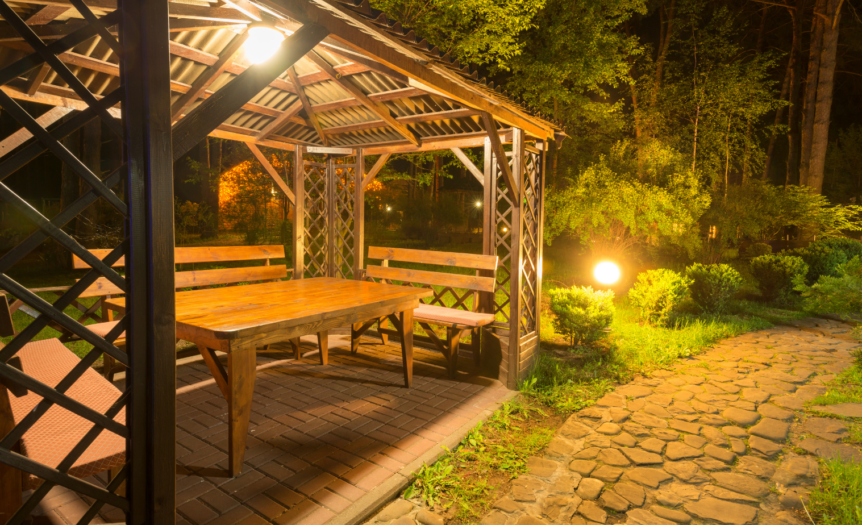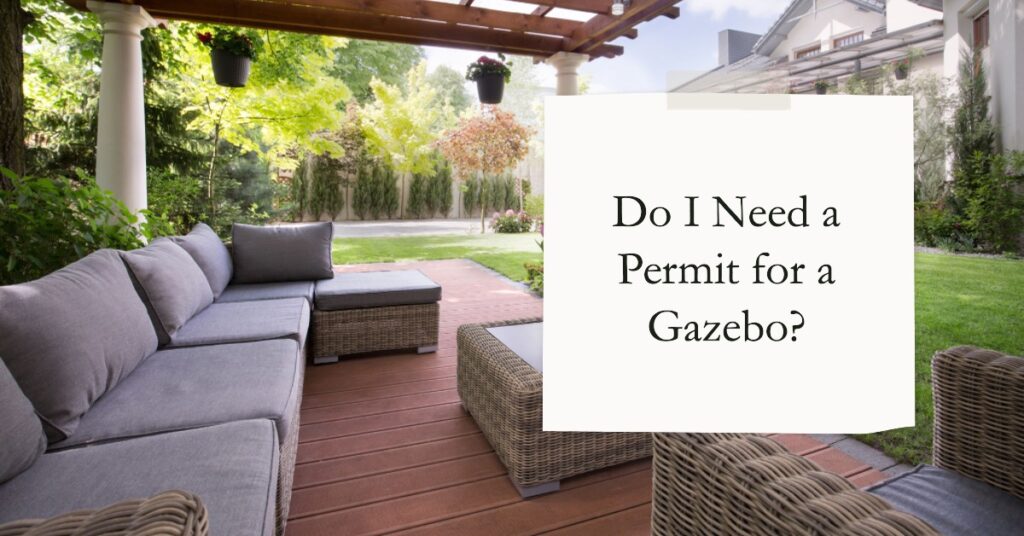If you’re considering enhancing your outdoor living space with a gazebo, it’s essential to understand the process and requirements surrounding building permits. Gazebos are popular garden structures that create shade, elegance, and bring families together during warm seasons.
But before diving into construction or purchasing a ready-to-assemble kit, ask yourself: “Do I need a permit for my new gazebo?” Permit regulations vary based on location, size, and style of the structure.
This blog post will walk you through understanding gazebo permits while providing helpful tips in obtaining one if necessary.
Understanding Gazebo Permits
To build a gazebo, it’s important to understand what a gazebo permit is and why it’s necessary, as well as who is responsible for obtaining one.
What Is A Gazebo Permit And Why Is It Necessary?
A gazebo permit is a formal authorization granted by local authorities to construct or install a gazebo on your property. It ensures that the proposed structure complies with all zoning laws, building codes, and land use regulations in place within your specific municipality, ensuring safety and adherence to community guidelines.
The necessity of obtaining a permit for your gazebo lies in preserving both public safety and long-term property value. For instance, when permits are issued, they typically require inspections at various stages during construction to ensure structural integrity and compliance with code requirements.
This process offers an added layer of protection against mishaps such as collapsing structures due to improper installation methods or poor material quality.
Who Is Responsible For Obtaining A Permit?
It is the responsibility of the property owner to obtain a permit for building a gazebo. This includes researching local regulations, filling out and submitting the necessary paperwork, paying any applicable fees, and waiting for approval before starting construction.
In some cases, it may be beneficial to consult with local authorities or homeowner associations to ensure all guidelines are being followed. Failure to obtain a permit can result in costly fines and legal action from neighbors or local authorities, as well as difficulties in obtaining insurance coverage and selling the property.
Permit Requirements For Gazebos
Before building a gazebo, it’s important to understand the permit requirements based on location and size.
Different Types Of Permits
There are various types of permits required for building a gazebo, pergola or pavilion depending on the location and state regulations. Some require planning permits which involve submitting site plans or architectural drawings before conducting any construction work, whereas others may need building permits that ensure compliance with zoning laws and US building codes.
In some places, you may even need additional permit approvals for installing running water, electricity or other utilities in your garden structure.
Specific Rules And Regulations Based On Location, Size, And Style
When it comes to building a gazebo, pergola, or pavilion, specific rules and regulations must be followed based on location, size, and style. For instance, in Prince George’s County, Maryland, gazebos that are less than 200 square feet do not require a permit.
Similarly in California where zoning laws vary by city and county; some cities may waive permits for structures such as gazebos under certain conditions while others may require permits for structures of any size that will have walls.
It is important to research and comply with local regulations before beginning construction of your gazebo to avoid potential consequences such as fines or required modifications later on.
Permit Fees And Processing Time
The fees and processing time for obtaining a gazebo permit vary depending on the location and the size of the structure. In general, fees can range from around $50 to several hundred dollars depending on the city or state where you live.
For example, in Prince George’s County in Maryland, a building permit for a residential gazebo costs $300 plus an additional inspection fee of $90. The processing time is typically 10-15 business days once all required documentation has been submitted.
Ultimately, obtaining a permit for your gazebo ensures that it meets local safety standards and codes, protecting both you and your property value in the long run.
Permit Application Documentation Checklist
To obtain a permit for your gazebo, you will need to submit an application that includes certain documentation. The exact requirements may vary depending on your location and the size of your structure, but generally, you will need to provide a site plan that shows the proposed location of the gazebo on your property.
This should include information like setbacks from property lines and any existing structures.
Additionally, you’ll likely need to provide proof of ownership or authorization from the property owner if you are not the homeowner yourself. Depending on where you live, other documentation such as fees, copies of insurance policies or agreements with utility companies might also be necessary.
Be sure to double-check with your local authorities to make sure all required documents have been submitted before proceeding with construction.
Benefits Of Obtaining A Permit For Your Gazebo
Obtaining a permit for your gazebo ensures structural integrity and safety, avoids potential legal and financial liabilities, protects property value, and provides peace of mind.
Ensures Safety And Structural Integrity
Obtaining a permit for your gazebo is not only a legal requirement, but it also ensures that the structure is safe and structurally sound. Building codes require certain standards to be met when constructing outdoor structures like gazebos, pergolas, or pavilions.
With a permit in hand, you can rest assured that your gazebo meets these requirements and has been inspected by local authorities for safety.
In Prince George’s County as well as other locations worldwide that require permits for building outdoor structures such as gazebos or pergolas, getting one will give you peace of mind knowing that your property value is protected against potential hazards from poorly constructed buildings.
Avoids Potential Legal And Financial Liabilities
Obtaining a permit for your gazebo can prevent potential legal and financial liabilities. Without a permit, you may face fines, required demolition or modifications, legal action from neighbors or local authorities, repercussions on insurance coverage, and difficulty in selling the property.
For example, if someone is injured on your property due to a faulty gazebo structure that was built without a permit, you could be held legally responsible for their injuries.
Additionally, if you try to sell your property with an illegally constructed gazebo on it, potential buyers may require you to demolish it before closing the sale.
Protects Property Value
Getting a permit for your gazebo can help protect the value of your property. A permitted gazebo provides assurance that it meets all necessary safety and construction guidelines, which in turn can lead to higher resale values if you ever decide to sell your home.
By contrast, an unpermitted structure may be seen as a liability by potential buyers who could be put off by the risk of fines or liability issues associated with non-permitted structures.
Additionally, having a permitted gazebo shows that you have taken care to follow local regulations and appear as someone who is responsible and conscientious.
Provides Peace Of Mind
Obtaining a permit for your gazebo can provide peace of mind by ensuring that you have followed all necessary regulations and guidelines. A permit indicates that the structure has been built to code, which means that it is safe and structurally sound.
Additionally, having the appropriate permits in place protects property values and avoids potential legal and financial liabilities. Without a permit, homeowners run the risk of being fined or ordered to remove their gazebo, causing stress and inconvenience.
Consequences Of Building Without A Permit
Building a gazebo without obtaining the necessary permits can result in significant consequences, including hefty fines or even legal action from local authorities or neighbors.
Fines And Penalties
Building a gazebo without a permit can result in significant fines and penalties. The amount of the fine or penalty will depend on various factors such as location, size, style, and type of structure being built.
For instance, in Prince George’s County Maryland, building a structure without a permit may lead to legal action from neighbors or local authorities that could result in costly civil court proceedings.
Additionally, any structures that are built without proper approvals are subject to demolition or modifications at the homeowner’s expense.
Required Demolition Or Modifications
If you build a gazebo without obtaining a permit, it could lead to potential consequences such as required demolition or modifications. If the structure is not up to code or poses any safety risks, local authorities may require it to be removed entirely or altered to meet building standards.
This can be costly and time-consuming, not to mention an inconvenience if you were already enjoying your newly-built gazebo. For example, in Prince George’s County, Maryland, unpermitted buildings must be either permitted or demolished within 30 days of receiving a violation notice from the county government.
Legal Action From Neighbors Or Local Authorities
If you build a gazebo or any other outdoor structure without obtaining the necessary permits, you may face legal action from your neighbors or local authorities. For instance, your neighbors may file complaints about noise levels, traffic congestion, or property damage caused by the construction process.
These consequences can have serious repercussions on your finances and peace of mind. In addition to facing fines and penalties for violating building regulations, you might be responsible for paying damages awarded in lawsuits filed by affected parties.
Furthermore, insurance companies may refuse to pay claims related to accidents or injuries caused by an unpermitted gazebo on your property.
Repercussions On Insurance Coverage
Building a gazebo without obtaining the necessary permits can have serious consequences, including impacts on your insurance coverage. It’s important to note that if you build a structure without following proper procedures and it later causes damage or an injury occurs, your insurer may deny coverage for any related claims.
This could leave you liable for costly repairs or medical expenses out of pocket.
To avoid these repercussions on your insurance coverage, it is crucial to ensure that you follow all applicable rules and regulations when building a gazebo. This includes researching local laws, consulting with authorities or homeowner associations where necessary, and obtaining all required permits before beginning construction.
Difficulty In Selling The Property
If you decide to build a gazebo without obtaining the necessary permit, it can significantly impact your ability to sell your property in the future. Unpermitted structures show up on property records and may raise red flags for potential buyers or real estate agents.
In some cases, this may lead them to avoid purchasing your home altogether.
It’s crucial to obtain the proper permits before beginning construction of any outdoor structure like a gazebo or pergola.
Tips On How To Obtain A Gazebo Permit
To ensure a smooth and hassle-free process when applying for a gazebo permit, it is essential to research local regulations, consult with local authorities or homeowner associations, complete the application accurately and thoroughly, and wait for approval before beginning construction.
Research Local Regulations
Before embarking on building a gazebo, it is important to research local regulations. City zoning laws and regulations vary depending on the location of your property. Some cities or states may have specific requirements that need to be met before you can start constructing your gazebo.
Researching local regulations will help you understand what permits are required for different types of construction projects like sheds, pergolas, and gazebos. You can also find out if there are any materials or design restrictions imposed by city planning authorities.
Consult With Local Authorities Or Homeowner Associations
Before building a gazebo, it is important to consult with local authorities or homeowner associations. They can provide information on local regulations and permit requirements that may be specific to your location.
For example, in Prince George’s County, Maryland, a permit for an outdoor structure like a gazebo may require site plans, construction guidelines and compliance with zoning laws.
Additionally, contacting these organizations early on in the planning process can save time and prevent potential issues down the road. They may also offer helpful tips on navigating the permitting process and connect you with additional resources if needed.
Complete The Permit Application Accurately And Thoroughly
When applying for a permit to build a gazebo, it is important to complete the application accurately and thoroughly. This means providing all required information and ensuring that it is correct.
Be sure to read through all instructions carefully before beginning your application. Make note of any required documentation, such as site plans or photos, and gather these materials ahead of time.
One common mistake when submitting permit applications is forgetting to sign or date the form. Don’t forget this crucial step! Additionally, be prepared to pay any fees associated with obtaining a permit for your gazebo project.
Wait For Approval Before Beginning Construction
It’s important to wait for approval before beginning construction on your gazebo. Failure to do so could result in consequences such as fines, required demolition or modifications, legal action from neighbors or local authorities, and repercussions on insurance coverage.
In addition to avoiding these negative outcomes, waiting for approval ensures that your gazebo meets all necessary safety regulations and structural requirements. To obtain a permit, research local regulations and consult with local authorities or homeowner associations.
Complete the permit application accurately and thoroughly and be sure to include any necessary documentation such as site plans or property restrictions.
Conclusion And Final Thoughts
In conclusion, knowing whether or not you need a permit for your gazebo is essential to ensure that your outdoor structure meets all the local regulations and laws. Obtaining a permit provides peace of mind, protects property value, and avoids legal and financial liabilities.
Building without a permit can result in severe consequences such as fines or being required to demolish the structure. Before building your dream gazebo, make sure to research the specific requirements for permits in your location, consult with authorities if necessary, complete necessary documentation accurately and thoroughly before beginning construction.
Related Posts
How to keep birds out of my gazebo
Can you put solar panels on a gazebo
What’s the difference between a gazebo and a pavilion
Where to put a gazebo in the backyard
How to keep a gazebo from blowing away
How to hang lights in a gazebo
How to hang gazebo curtains
How to screen a gazebo
How to level a gazebo on sloped concrete
What to do with an old metal gazebo frame
How to move a gazebo
How to build a gazebo on a deck
How to anchor a gazebo without drilling
How to decorate a gazebo for a wedding
How much does a gazebo cost
How to build a gazebo roof
What is a gazebo used for
What is the difference between a gazebo and pergola







